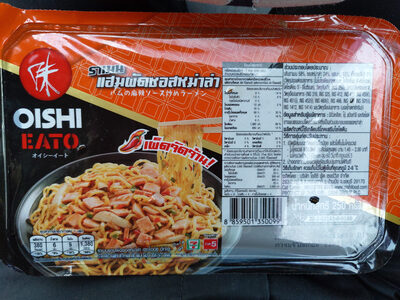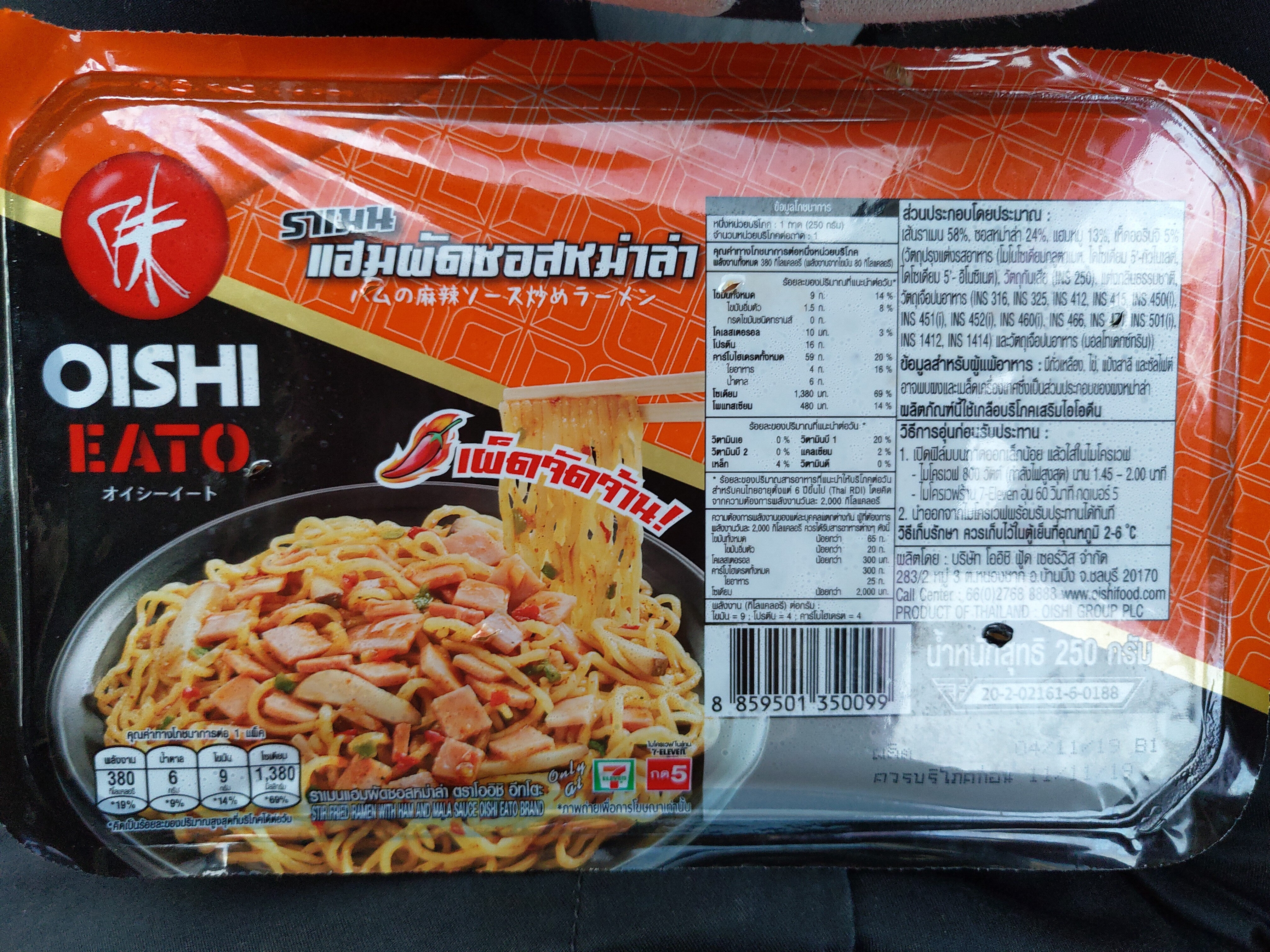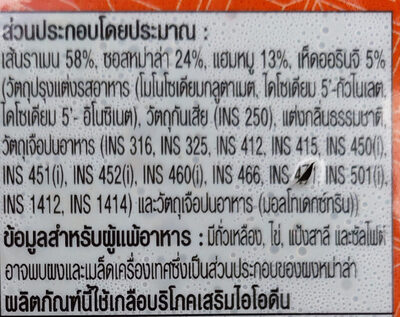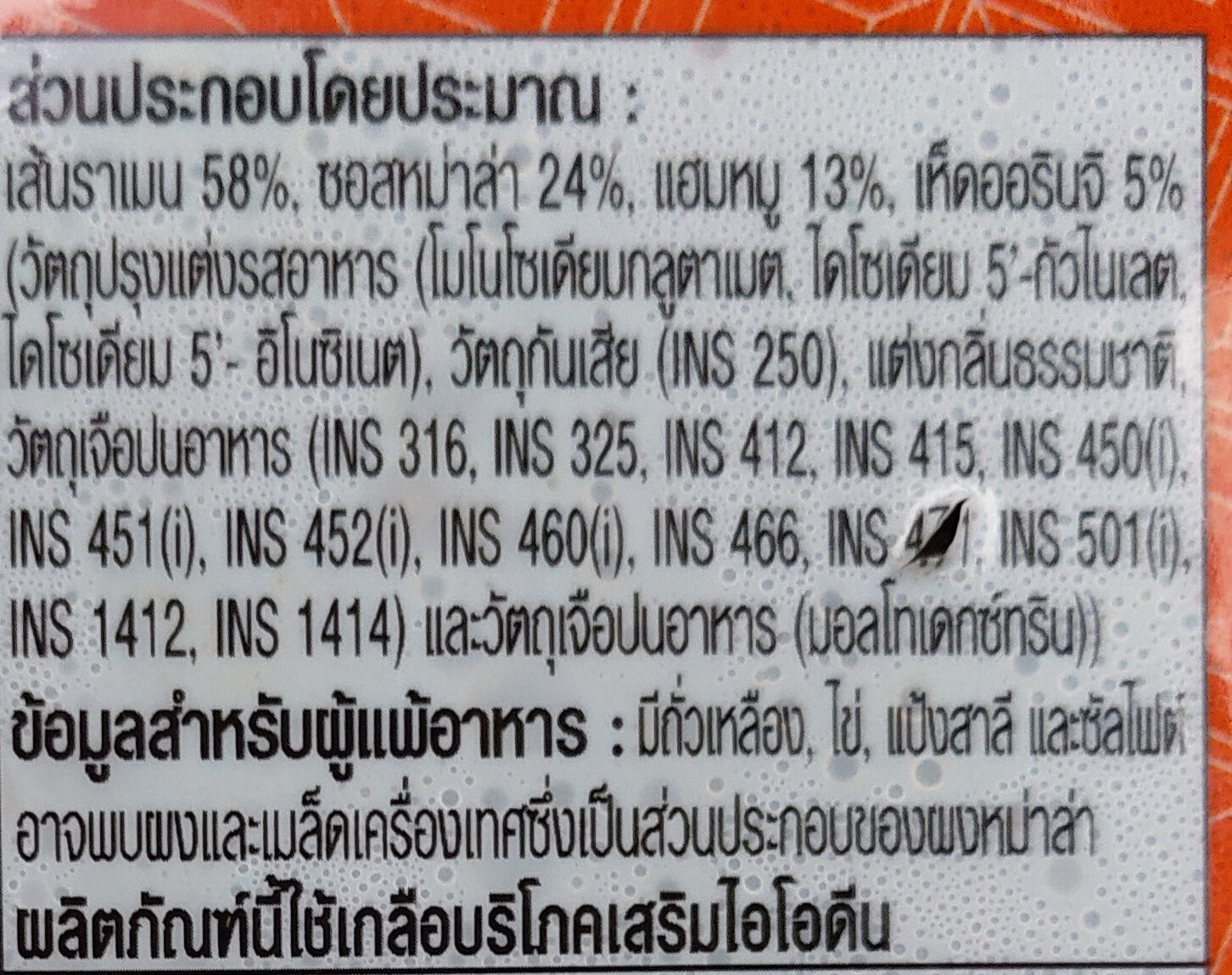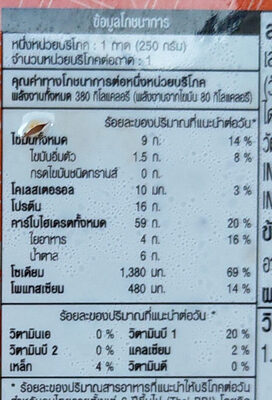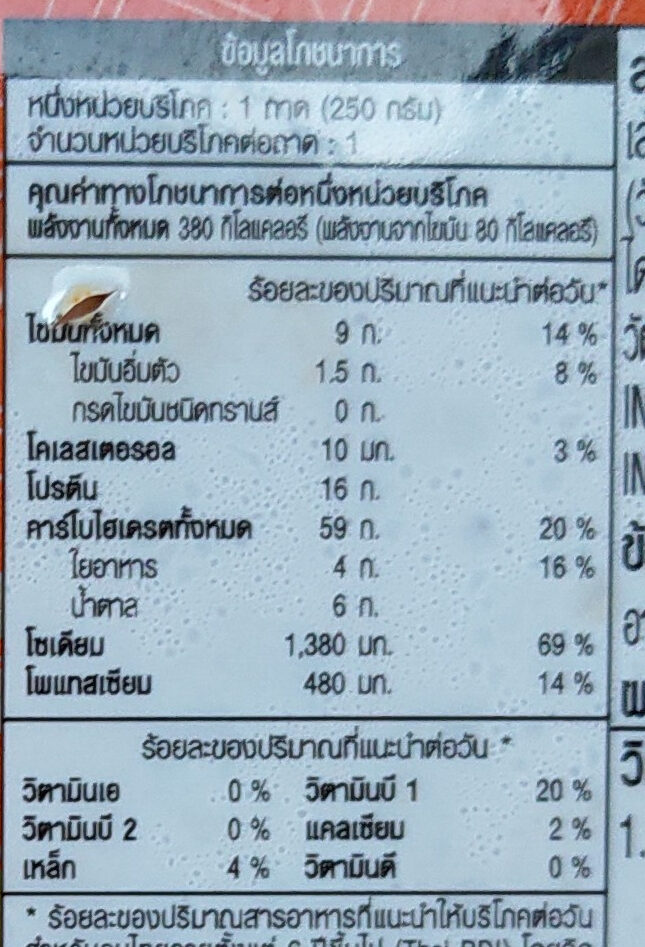Help us make food transparency the norm!
As a non-profit organization, we depend on your donations to continue informing consumers around the world about what they eat.
The food revolution starts with you!
ราเมนแฮมผัดซอสหม่าล่า - โออิชิ - 250 g
ราเมนแฮมผัดซอสหม่าล่า - โออิชิ - 250 g
This product page is not complete. You can help to complete it by editing it and adding more data from the photos we have, or by taking more photos using the app for Android or iPhone/iPad. Thank you!
×
Barcode: 8859501350099 (EAN / EAN-13)
Quantity: 250 g
Packaging: Tray
Brands: โออิชิ, Oishi, อีทโตะ, Eato
Categories: Plant-based foods and beverages, Plant-based foods, Fruits and vegetables based foods, Cereals and potatoes, Vegetables based foods, Cereals and their products, Pastas, Noodles
Countries where sold: Thailand
Matching with your preferences
Health
Ingredients
-
22 ingredients
: เส้นราเมน 58%, ซอสหม่าล่า 24% แฮมหมู 13% เห็ดออรินจิ 5% (วัตถุปรุงแต่งรสอาหาร (โมโนโซเดียมกลูตามต, ไดโซเดียม 5-ัวโนเลต ไดโซเดียม 5 - อิโนซิเนต), วัตถุกันเสีย (INS 250), แต่งกลิ่นธรรมชาติ ns (INS 316, INS 325, INS 412, INS 415, INS 450(0 INS 451(), INS 452(), INS 460), INS 466, INSINS 5010 INS 1412, INS 1414) มอลโทเดกซ์ทริน ข้อมูลสำหรับผู้แพ้อาหาร : มีถั่วหลือ, ไข่ แป้งสาลี และซัลไฟต์ อาจพบผงและเมล็ดเครื่องเทศซึ่งเป็นส่วนประกอบของผงหม่าล่า ผลิตภัณฑ์นี้ใช้เกลือบริโภคเสริมไอโอดีน
Food processing
-
Ultra processed foods
Elements that indicate the product is in the 4 - Ultra processed food and drink products group:
- Additive: E325 - Sodium lactate
- Additive: E412 - Guar gum
- Additive: E415 - Xanthan gum
- Additive: E450 - Diphosphates
- Additive: E452 - Polyphosphates
- Additive: E460 - Cellulose
- Additive: E466 - Sodium carboxy methyl cellulose
Food products are classified into 4 groups according to their degree of processing:
- Unprocessed or minimally processed foods
- Processed culinary ingredients
- Processed foods
- Ultra processed foods
The determination of the group is based on the category of the product and on the ingredients it contains.
Additives
-
E250 - Sodium nitrite
Sodium nitrite: Sodium nitrite is the inorganic compound with the chemical formula NaNO2. It is a white to slightly yellowish crystalline powder that is very soluble in water and is hygroscopic. It is a useful precursor to a variety of organic compounds, such as pharmaceuticals, dyes, and pesticides, but it is probably best known as a food additive to prevent botulism. It is on the World Health Organization's List of Essential Medicines, the most important medications needed in a basic health system.Nitrate or nitrite -ingested- under conditions that result in endogenous nitrosation has been classified as "probably carcinogenic to humans" by International Agency for Research on Cancer -IARC-.Source: Wikipedia
-
E316 - Sodium erythorbate
Sodium erythorbate: Sodium erythorbate -C6H7NaO6- is a food additive used predominantly in meats, poultry, and soft drinks. Chemically, it is the sodium salt of erythorbic acid. When used in processed meat such as hot dogs and beef sticks, it increases the rate at which nitrite reduces to nitric oxide, thus facilitating a faster cure and retaining the pink coloring. As an antioxidant structurally related to vitamin C, it helps improve flavor stability and prevents the formation of carcinogenic nitrosamines. When used as a food additive, its E number is E316. The use of erythorbic acid and sodium erythorbate as a food preservative has increased greatly since the U.S. Food and Drug Administration banned the use of sulfites as preservatives in foods intended to be eaten fresh -such as ingredients for fresh salads- and as food processors have responded to the fact that some people are allergic to sulfites. It can also be found in bologna, and is occasionally used in beverages, baked goods, and potato salad.Sodium erythorbate is produced from sugars derived from different sources, such as beets, sugar cane, and corn. An urban myth claims that sodium erythorbate is made from ground earthworms; however, there is no truth to the myth. It is thought that the genesis of the legend comes from the similarity of the chemical name to the words earthworm and bait.Alternative applications include the development of additives that could be utilized as anti-oxidants in general. For instance, this substance has been implemented in the development of corrosion inhibitors for metals and it has been implemented in active packaging.Sodium erythorbate is soluble in water. The pH of the aqueous solution of the sodium salt is between 5 and 6. A 10% solution, made from commercial grade sodium erythorbate, may have a pH of 7.2 to 7.9. In its dry, crystalline state it is nonreactive. But, when in solution with water it readily reacts with atmospheric oxygen and other oxidizing agents, which makes it a valuable antioxidant.Source: Wikipedia
-
E325 - Sodium lactate
Sodium lactate: Sodium lactate is the sodium salt of lactic acid, and has a mild saline taste. It is produced by fermentation of a sugar source, such as corn or beets, and then, by neutralizing the resulting lactic acid to create a compound having the formula NaC3H5O3.Source: Wikipedia
-
E412 - Guar gum
Guar gum (E412) is a natural food additive derived from guar beans.
This white, odorless powder is valued for its remarkable thickening and stabilizing properties, making it a common ingredient in various food products, including sauces, dressings, and ice creams.
When used in moderation, guar gum is considered safe for consumption, with no known adverse health effects.
-
E415 - Xanthan gum
Xanthan gum (E415) is a natural polysaccharide derived from fermented sugars, often used in the food industry as a thickening and stabilizing agent.
This versatile food additive enhances texture and prevents ingredient separation in a wide range of products, including salad dressings, sauces, and gluten-free baked goods.
It is considered safe for consumption even at high intake amounts.
-
E450 - Diphosphates
Diphosphates (E450) are food additives often utilized to modify the texture of products, acting as leavening agents in baking and preventing the coagulation of canned food.
These salts can stabilize whipped cream and are also found in powdered products to maintain their flow properties. They are commonly present in baked goods, processed meats, and soft drinks.
Derived from phosphoric acid, they're part of our daily phosphate intake, which often surpasses recommended levels due to the prevalence of phosphates in processed foods and drinks.
Excessive phosphate consumption is linked to health issues, such as impaired kidney function and weakened bone health. Though diphosphates are generally regarded as safe when consumed within established acceptable daily intakes, it's imperative to monitor overall phosphate consumption to maintain optimal health.
-
E460 - Cellulose
Cellulose: Cellulose is an organic compound with the formula -C6H10O5-n, a polysaccharide consisting of a linear chain of several hundred to many thousands of β-1→4- linked D-glucose units. Cellulose is an important structural component of the primary cell wall of green plants, many forms of algae and the oomycetes. Some species of bacteria secrete it to form biofilms. Cellulose is the most abundant organic polymer on Earth. The cellulose content of cotton fiber is 90%, that of wood is 40–50%, and that of dried hemp is approximately 57%.Cellulose is mainly used to produce paperboard and paper. Smaller quantities are converted into a wide variety of derivative products such as cellophane and rayon. Conversion of cellulose from energy crops into biofuels such as cellulosic ethanol is under development as a renewable fuel source. Cellulose for industrial use is mainly obtained from wood pulp and cotton.Some animals, particularly ruminants and termites, can digest cellulose with the help of symbiotic micro-organisms that live in their guts, such as Trichonympha. In human nutrition, cellulose is a non-digestible constituent of insoluble dietary fiber, acting as a hydrophilic bulking agent for feces and potentially aiding in defecation.Source: Wikipedia
-
E466 - Sodium carboxy methyl cellulose
Carboxymethyl cellulose: Carboxymethyl cellulose -CMC- or cellulose gum or tylose powder is a cellulose derivative with carboxymethyl groups --CH2-COOH- bound to some of the hydroxyl groups of the glucopyranose monomers that make up the cellulose backbone. It is often used as its sodium salt, sodium carboxymethyl cellulose.Source: Wikipedia
Ingredients analysis
-
Palm oil content unknown
Unrecognized ingredients: th:เส้นราเมน, th:ซอสหม่าล่า-24-แฮมหมู-13-เห็ดออรินจิ, th:วัตถุปรุงแต่งรสอาหาร, th:โมโนโซเดียมกลูตามต, th:ไดโซเดียม-5-ัวโนเลต-ไดโซเดียม-5, th:อิโนซิเนต, th:วัตถุกันเสีย, th:แต่งกลิ่นธรรมชาติ-ns, th:0-e451, th:insins-5010-e1412, th:e1414-มอลโทเดกซ์ทริน-ข้อมูลสำหรับผู้แพ้อาหาร, th:มีถั่วหลือ, th:ไข่-แป้งสาลี-และซัลไฟต์-อาจพบผงและเมล็ดเครื่องเทศซึ่งเป็นส่วนประกอบของผงหม่าล่า-ผลิตภัณฑ์นี้ใช้เกลือบริโภคเสริมไอโอดีนSome ingredients could not be recognized.
We need your help!
You can help us recognize more ingredients and better analyze the list of ingredients for this product and others:
- Edit this product page to correct spelling mistakes in the ingredients list, and/or to remove ingredients in other languages and sentences that are not related to the ingredients.
- Add new entries, synonyms or translations to our multilingual lists of ingredients, ingredient processing methods, and labels.
If you would like to help, join the #ingredients channel on our Slack discussion space and/or learn about ingredients analysis on our wiki. Thank you!
-
Vegan status unknown
Unrecognized ingredients: th:เส้นราเมน, th:ซอสหม่าล่า-24-แฮมหมู-13-เห็ดออรินจิ, th:วัตถุปรุงแต่งรสอาหาร, th:โมโนโซเดียมกลูตามต, th:ไดโซเดียม-5-ัวโนเลต-ไดโซเดียม-5, th:อิโนซิเนต, th:วัตถุกันเสีย, th:แต่งกลิ่นธรรมชาติ-ns, th:0-e451, th:insins-5010-e1412, th:e1414-มอลโทเดกซ์ทริน-ข้อมูลสำหรับผู้แพ้อาหาร, th:มีถั่วหลือ, th:ไข่-แป้งสาลี-และซัลไฟต์-อาจพบผงและเมล็ดเครื่องเทศซึ่งเป็นส่วนประกอบของผงหม่าล่า-ผลิตภัณฑ์นี้ใช้เกลือบริโภคเสริมไอโอดีนSome ingredients could not be recognized.
We need your help!
You can help us recognize more ingredients and better analyze the list of ingredients for this product and others:
- Edit this product page to correct spelling mistakes in the ingredients list, and/or to remove ingredients in other languages and sentences that are not related to the ingredients.
- Add new entries, synonyms or translations to our multilingual lists of ingredients, ingredient processing methods, and labels.
If you would like to help, join the #ingredients channel on our Slack discussion space and/or learn about ingredients analysis on our wiki. Thank you!
-
Vegetarian status unknown
Unrecognized ingredients: th:เส้นราเมน, th:ซอสหม่าล่า-24-แฮมหมู-13-เห็ดออรินจิ, th:วัตถุปรุงแต่งรสอาหาร, th:โมโนโซเดียมกลูตามต, th:ไดโซเดียม-5-ัวโนเลต-ไดโซเดียม-5, th:อิโนซิเนต, th:วัตถุกันเสีย, th:แต่งกลิ่นธรรมชาติ-ns, th:0-e451, th:insins-5010-e1412, th:e1414-มอลโทเดกซ์ทริน-ข้อมูลสำหรับผู้แพ้อาหาร, th:มีถั่วหลือ, th:ไข่-แป้งสาลี-และซัลไฟต์-อาจพบผงและเมล็ดเครื่องเทศซึ่งเป็นส่วนประกอบของผงหม่าล่า-ผลิตภัณฑ์นี้ใช้เกลือบริโภคเสริมไอโอดีนSome ingredients could not be recognized.
We need your help!
You can help us recognize more ingredients and better analyze the list of ingredients for this product and others:
- Edit this product page to correct spelling mistakes in the ingredients list, and/or to remove ingredients in other languages and sentences that are not related to the ingredients.
- Add new entries, synonyms or translations to our multilingual lists of ingredients, ingredient processing methods, and labels.
If you would like to help, join the #ingredients channel on our Slack discussion space and/or learn about ingredients analysis on our wiki. Thank you!
-
Details of the analysis of the ingredients
We need your help!
Some ingredients could not be recognized.
We need your help!
You can help us recognize more ingredients and better analyze the list of ingredients for this product and others:
- Edit this product page to correct spelling mistakes in the ingredients list, and/or to remove ingredients in other languages and sentences that are not related to the ingredients.
- Add new entries, synonyms or translations to our multilingual lists of ingredients, ingredient processing methods, and labels.
If you would like to help, join the #ingredients channel on our Slack discussion space and/or learn about ingredients analysis on our wiki. Thank you!
: เส้นราเมน 58%, ซอสหม่าล่า 24% แฮมหมู 13% เห็ดออรินจิ 5%, วัตถุปรุงแต่งรสอาหาร (โมโนโซเดียมกลูตามต, ไดโซเดียม 5-ัวโนเลต ไดโซเดียม 5, อิโนซิเนต), วัตถุกันเสีย (e250), แต่งกลิ่นธรรมชาติ ns, e316, e325, e412, e415, e450, 0 e451, e452, e460, e466, INSINS 5010 e1412, e1414) มอลโทเดกซ์ทริน ข้อมูลสำหรับผู้แพ้อาหาร (มีถั่วหลือ), ไข่ แป้งสาลี และซัลไฟต์ อาจพบผงและเมล็ดเครื่องเทศซึ่งเป็นส่วนประกอบของผงหม่าล่า ผลิตภัณฑ์นี้ใช้เกลือบริโภคเสริมไอโอดีน- เส้นราเมน -> th:เส้นราเมน - percent_min: 58 - percent: 58 - percent_max: 58
- ซอสหม่าล่า 24% แฮมหมู 13% เห็ดออรินจิ -> th:ซอสหม่าล่า-24-แฮมหมู-13-เห็ดออรินจิ - percent_min: 5 - percent: 5 - percent_max: 5
- วัตถุปรุงแต่งรสอาหาร -> th:วัตถุปรุงแต่งรสอาหาร - percent_min: 2.46666666666667 - percent_max: 5
- โมโนโซเดียมกลูตามต -> th:โมโนโซเดียมกลูตามต - percent_min: 0.822222222222222 - percent_max: 5
- ไดโซเดียม 5-ัวโนเลต ไดโซเดียม 5 -> th:ไดโซเดียม-5-ัวโนเลต-ไดโซเดียม-5 - percent_min: 0 - percent_max: 2.5
- อิโนซิเนต -> th:อิโนซิเนต - percent_min: 0 - percent_max: 1.66666666666667
- วัตถุกันเสีย -> th:วัตถุกันเสีย - percent_min: 2.28571428571429 - percent_max: 5
- e250 -> en:e250 - vegan: yes - vegetarian: yes - percent_min: 2.28571428571429 - percent_max: 5
- แต่งกลิ่นธรรมชาติ ns -> th:แต่งกลิ่นธรรมชาติ-ns - percent_min: 2.07692307692308 - percent_max: 5
- e316 -> en:e316 - vegan: yes - vegetarian: yes - percent_min: 1.83333333333333 - percent_max: 5
- e325 -> en:e325 - vegan: yes - vegetarian: yes - percent_min: 1.54545454545455 - percent_max: 5
- e412 -> en:e412 - vegan: yes - vegetarian: yes - percent_min: 1.2 - percent_max: 4.87642912642913
- e415 -> en:e415 - vegan: yes - vegetarian: yes - percent_min: 0.791507874841208 - percent_max: 4.00836782265354
- e450 -> en:e450 - vegan: yes - vegetarian: yes - percent_min: 0.389400381364666 - percent_max: 3.40838336046669
- 0 e451 -> th:0-e451 - percent_min: 0 - percent_max: 2.9864073891521
- e452 -> en:e452 - vegan: yes - vegetarian: yes - percent_min: 0 - percent_max: 2.68776665023689
- e460 -> en:e460 - vegan: yes - vegetarian: yes - percent_min: 0 - percent_max: 2.44342422748808
- e466 -> en:e466 - vegan: yes - vegetarian: yes - percent_min: 0 - percent_max: 2.23980554186407
- INSINS 5010 e1412 -> th:insins-5010-e1412 - percent_min: 0 - percent_max: 2.06751280787453
- e1414) มอลโทเดกซ์ทริน ข้อมูลสำหรับผู้แพ้อาหาร -> th:e1414-มอลโทเดกซ์ทริน-ข้อมูลสำหรับผู้แพ้อาหาร - percent_min: 0 - percent_max: 1.91983332159778
- มีถั่วหลือ -> th:มีถั่วหลือ - percent_min: 0 - percent_max: 1.91983332159778
- ไข่ แป้งสาลี และซัลไฟต์ อาจพบผงและเมล็ดเครื่องเทศซึ่งเป็นส่วนประกอบของผงหม่าล่า ผลิตภัณฑ์นี้ใช้เกลือบริโภคเสริมไอโอดีน -> th:ไข่-แป้งสาลี-และซัลไฟต์-อาจพบผงและเมล็ดเครื่องเทศซึ่งเป็นส่วนประกอบของผงหม่าล่า-ผลิตภัณฑ์นี้ใช้เกลือบริโภคเสริมไอโอดีน - percent_min: 0 - percent_max: 1.79184443349126
Nutrition
-
Average nutritional quality
⚠ ️Warning: the amount of fruits, vegetables and nuts is not specified on the label, it was estimated from the list of ingredients: 0This product is not considered a beverage for the calculation of the Nutri-Score.
Positive points: 4
- Proteins: 3 / 5 (value: 6.4, rounded value: 6.4)
- Fiber: 1 / 5 (value: 1.6, rounded value: 1.6)
- Fruits, vegetables, nuts, and colza/walnut/olive oils: 0 / 5 (value: 0, rounded value: 0)
Negative points: 7
- Energy: 1 / 10 (value: 636, rounded value: 636)
- Sugars: 0 / 10 (value: 2.4, rounded value: 2.4)
- Saturated fat: 0 / 10 (value: 0.6, rounded value: 0.6)
- Sodium: 6 / 10 (value: 552, rounded value: 552)
The points for proteins are counted because the negative points are less than 11.
Nutritional score: (7 - 4)
Nutri-Score:
-
Nutrient levels
-
Fat in moderate quantity (3.6%)
What you need to know- A high consumption of fat, especially saturated fats, can raise cholesterol, which increases the risk of heart diseases.
Recommendation: Limit the consumption of fat and saturated fat- Choose products with lower fat and saturated fat content.
-
Saturated fat in low quantity (0.6%)
What you need to know- A high consumption of fat, especially saturated fats, can raise cholesterol, which increases the risk of heart diseases.
Recommendation: Limit the consumption of fat and saturated fat- Choose products with lower fat and saturated fat content.
-
Sugars in low quantity (2.4%)
What you need to know- A high consumption of sugar can cause weight gain and tooth decay. It also augments the risk of type 2 diabetes and cardio-vascular diseases.
Recommendation: Limit the consumption of sugar and sugary drinks- Sugary drinks (such as sodas, fruit beverages, and fruit juices and nectars) should be limited as much as possible (no more than 1 glass a day).
- Choose products with lower sugar content and reduce the consumption of products with added sugars.
-
Salt in moderate quantity (1.38%)
What you need to know- A high consumption of salt (or sodium) can cause raised blood pressure, which can increase the risk of heart disease and stroke.
- Many people who have high blood pressure do not know it, as there are often no symptoms.
- Most people consume too much salt (on average 9 to 12 grams per day), around twice the recommended maximum level of intake.
Recommendation: Limit the consumption of salt and salted food- Reduce the quantity of salt used when cooking, and don't salt again at the table.
- Limit the consumption of salty snacks and choose products with lower salt content.
-
-
Nutrition facts
Nutrition facts As sold
for 100 g / 100 mlAs sold
per serving (250 g, 1 tray)Compared to: Noodles Energy 636 kj
(152 kcal)1,590 kj
(380 kcal)-51% Fat 3.6 g 9 g -40% Saturated fat 0.6 g 1.5 g -74% Carbohydrates 23.6 g 59 g -55% Sugars 2.4 g 6 g +2% Fiber 1.6 g 4 g -39% Proteins 6.4 g 16 g -26% Salt 1.38 g 3.45 g +3% Potassium 192 mg 480 mg -6% Fruits‚ vegetables‚ nuts and rapeseed‚ walnut and olive oils (estimate from ingredients list analysis) 0 % 0 %
Environment
-
Eco-Score not computed - Unknown environmental impact
We could not compute the Eco-Score of this product as it is missing some data, could you help complete it?Could you add a precise product category so that we can compute the Eco-Score? Add a category
Packaging
-
Packaging with a medium impact
-
Packaging parts
Tray
-
Packaging materials
Material % Packaging weight Packaging weight per 100 g of product
-
Transportation
-
Origins of ingredients
Missing origins of ingredients information
⚠ ️ The origins of the ingredients of this product are not indicated.
If they are indicated on the packaging, you can modify the product sheet and add them.
If you are the manufacturer of this product, you can send us the information with our free platform for producers.Add the origins of ingredients for this product Add the origins of ingredients for this product
Report a problem
-
Incomplete or incorrect information?
Category, labels, ingredients, allergens, nutritional information, photos etc.
If the information does not match the information on the packaging, please complete or correct it. Open Food Facts is a collaborative database, and every contribution is useful for all.
Data sources
Product added on by bank-pc
Last edit of product page on by packbot.
Product page also edited by openfoodfacts-contributors.
